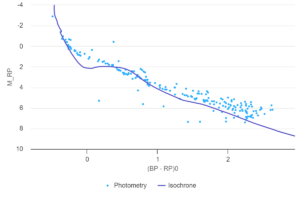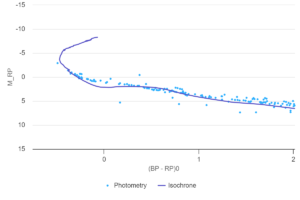NGC 2571 is an open young Cluster in the Puppis Constellation, and it is situated of the south celestial equator means it is more easily visible from the southern Hemisphere. NGC 2571 was identified during the era of systematic sky surveys in the 19th century, and it was Compiled by John Dreyer in 1880’s). open cluster NGC 2571 is among the clusters used by astronomers to calibrate distances scales in the universe. Means it is fundamental to our understanding of the size and scale of the universe. The age range of NGC 2571is in few million years (between 5-10 Myrs) for very young cluster.
To analyze NGC 2571 and explore the connection between blue, red, and green colors, brightness, age and the chemical composition of the cluster as a whole. I collected 15 images in the following filters, R, V and B with PROMPT-MO-1 telescope, with the total exposure durations of 15 seconds with R, V and B filters with other imaging parameters, using Skynet. For my analysis of NGC 2571, I used Afterglow for aligning, stacking, calibrating and photometry my observation. I also use Cluster Astromancer to analysis my data through field star removal to visualize my star cluster, archive fetching such as Gaia etc, and isochrone matching on the Hertzsprung-Russel diagram.
The objective of this work was to learn and get familiar with analyzing a star cluster using different analysis tools like Afterglow and Astromancer. With that, it will help me to know if my cluster is a young cluster or a globular cluster. The analysis of NGC 2571 was very interesting especially with afterglow when you are aligning, stacking, calibrating and the photometry of the 15 images collected from Skynet. The most thing I enjoyed was classifying the stars in the cluster with the 3 mains colors red, blue and green to identify if it is a young cluster or globular cluster. After, I use cluster Astromancer which helped in the removal of the corresponding field stars (means the contamination of the cluster), used Gaia archive fetching data to plot on isochrone matching (HR-diagram) for fitting the interpolation curve, I measured various important parameters. NGC 2571 is an open young cluster with 213 stars, 7909 solar Mass, proper Motion RA: – 4.93 (mas/yr.), Proper Motion Dec: 4.27 (mas/yr.), angular radius: 0.087degree, velocity dispersion: 0.12 (mas/yr.), Distance: 1.88 (kpc), Log Age: 6.85 log(yrs.) Age: 7.08 (Myrs) 7.08, Metallicity: -0.6 (solar), Reddening: 0.23 (mag). 

I was able to identify that NGC 2571 is a young cluster with the age of 7.08 Myrs and in the tri-color cluster image does show some 2 to 3 red giants stars but with a lot of blue stragglers. It was a little bit challenging during the field star removal to get the right cluster because my data seemed to show me two clusters.NGC 2571 was studied by Kharchenko et al in 2013 from Gaia and its parameters shows that log Age: 7.35 log (yrs.), the distance of 1.33 Kpc, cluster radius of 0.19 degree. The parameters values of my analysis on NGC 2571 were pretty much close to the ones Kharchenko et al got in 2013. With the recent data i collected this year (2024) the small difference values could be due to the data acquisition in 2013. This is, the dynamic of the universe, cluster star is constantly changing (moving), so getting exact values is not possible. The parameters values for this year were a little bit higher than the ones from Kharchenko et al in 2013.
When I started working on my analysis, it was bit confusing because I was not getting what I was asked for. Overall by the end of the analysis I did enjoyed the process of getting the right parameters. Now I feel more comfortable working with different analysis data tools, learning, and getting the understanding of the universe.